Summary: DevOps = Development + Operations. Digital businesses chase this holy grail of tech maturity. It’s not a plaque you hang on the wall; it’s a continuous cycle of improvements through investment in people & processes. Through this piece, we hope to educate the CXOs and their teams on how to build a culture of DevOps in ten steps. Of course, we’ll tell you about the things to avoid as well.
One essential factor that brings tailwinds for the agile transformation journey is DevOps, the amalgamation of development and operations. Building a DevOps culture aims to break the siloed structures within the organizational hierarchy and bring collaboration, shared responsibility, and communication to the forefront.
The upshot is reduced lead time and technical debt, faster time to market, and, thus, better product development.
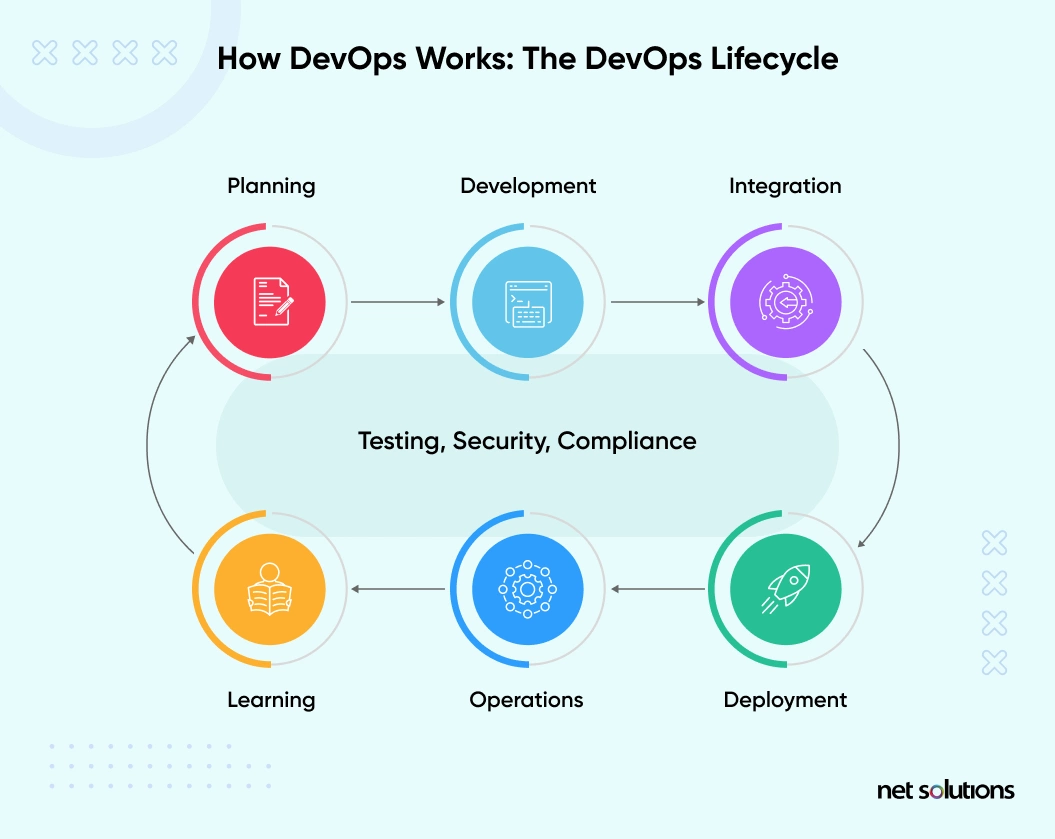
The DevOps team works in a group with a common motive — to offer a product that works well on all fronts, i.e., requirement adherence, design, development, testing, deployment, and maintenance. The team believes — alone, we can do so little; together, we can do so much!
What is DevOps Culture?
DevOps is a portmanteau, i.e., a combination of Development and Operations. It is a set of practices that the organization follows to enhance the software development life cycle process. In the right words, it is a cultural shift where the development and the operations team consciously and intuitively collaborate and communicate to foster productivity.
DevOps is a set of practices intended to reduce the time between committing a change to a system and the change being placed into normal production while ensuring high quality. — Len Bass, Ingo Weber, and Liming Zhu, Computer Science Researchers
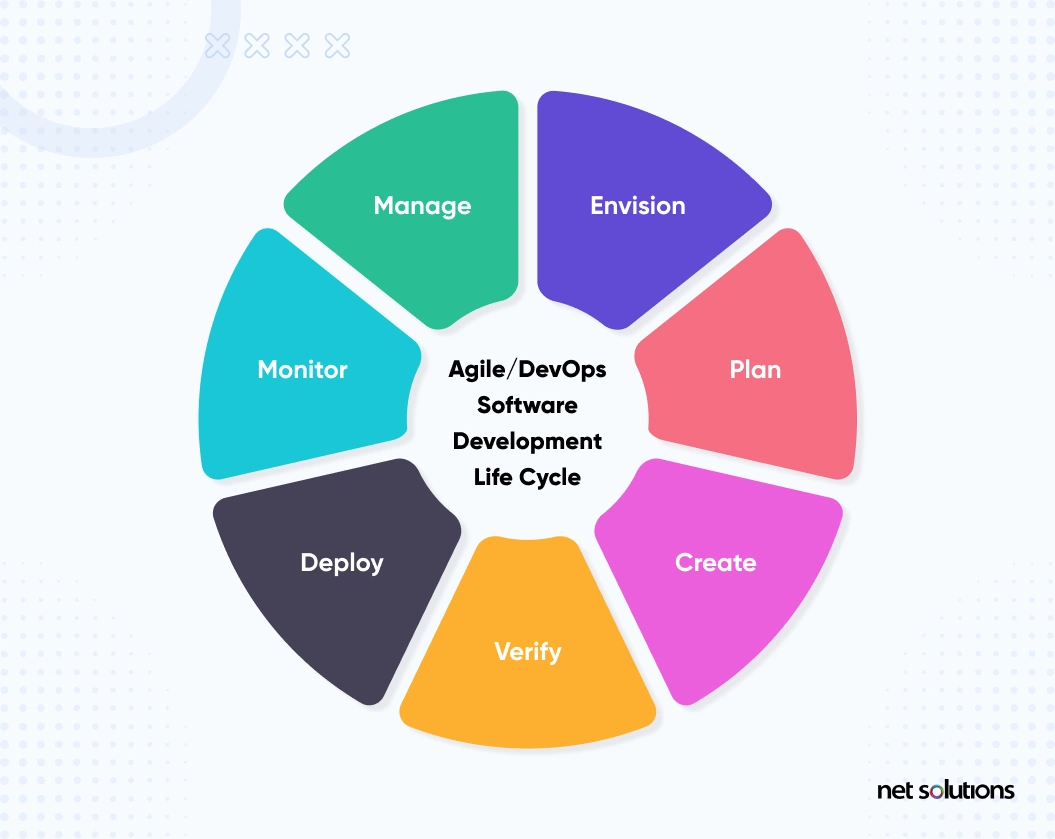
DevOps Culture: Principles
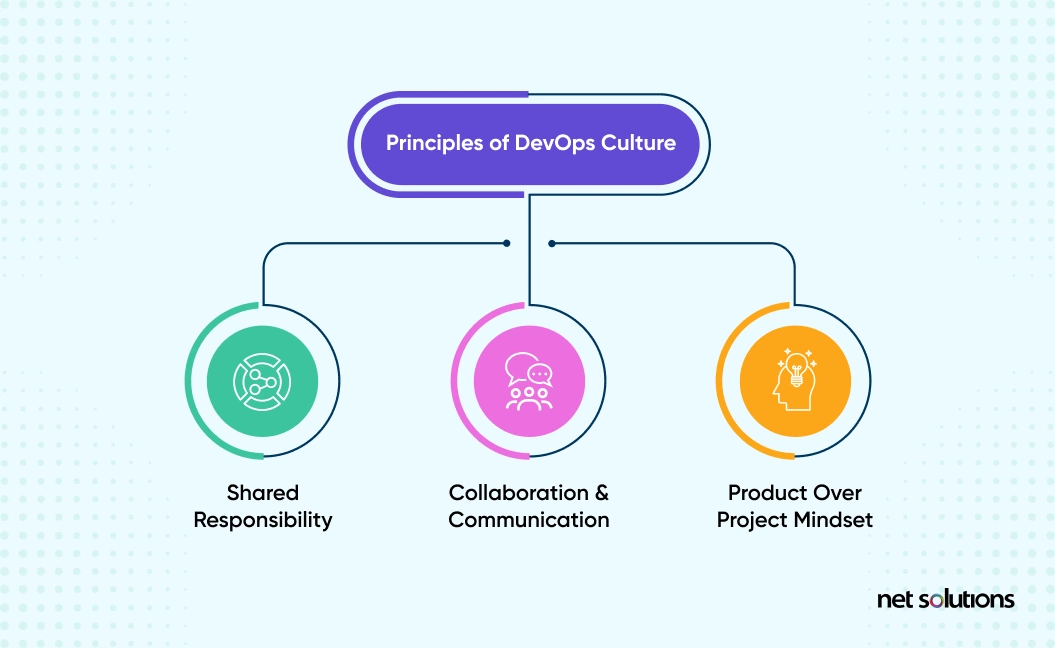
1. Shared Responsibility
The core objective of incorporating DevOps solutions is for the development team to work with the operations team. It is about understanding that the product development and operations teams have a shared responsibility for product deployment and maintenance.
The ops team needs to be more involved with Agile Software Development — being proactive is the key here. If the Dev and Ops team are co-located, share responsibilities, and understand roles — you can expect your product to succeed.
2. Collaboration and Communication
In an entrenched DevOps culture, there is no place for siloes between development and operations. This happens when the team collaborates and continuously communicates to offer continuous integration and delivery. While the development team focuses on delivering user stories, the operations team maintains the product’s all-time availability and security.
The DevOps framework involves teams working in a cross-functional setup to achieve the mentioned goals throughout the software development life cycle. If things fall into place from the beginning, it will likely cause fewer headaches in the long run.
3. Product Over Project Mindset
The traditional mindset that has been prevalent for years is that – once our task is completed, we’ll hand it over to the next team and move on. They forget that this passing over the baton and stepping aside is not the end goal, i.e., delivering the assigned task and forgetting about it is not synonymous with growth.
You will have to engrave a product mindset over the project mindset. You will have to take care of the product as a team throughout its lifetime by changing course and not looking back when the project ends. Adopting a DevOps culture mindset will ensure that your team inclines towards the product mindset that, in turn, helps in better management of continuous integration and delivery.
Benefits of DevOps Culture
DevOps brings value to the table. Here are some benefits that will answer what is driving the adoption of DevOps today:
1. Delivers Customer Value
With the automation of CI/CD pipelines, the speed of delivery and deployment increases. The DevOps cultural shift ensures that you have a workable product that solves users’ problems and is available and running at all times. This, in turn, implies that customer value is given utmost priority.
2. Breaking Existing Silos
DevOps aims to break the existing silos between the two teams by amalgamating the development and operations teams. The two teams communicate, collaborate, attend scrum meetings, and even conduct retrospectives. The DevOps works as a single unit to ensure that development and the associated operations are in harmony.
3. Better Focus on Core Functionalities
Building a DevOps team means the manual processing and approval seeking will take a backseat. The continuous integration, delivery, and deployment, i.e., the CI/CD pipeline, is a significant ingredient in enabling a DevOps culture, which means automation will take over the primary process of the product development and the subsequent deployment process.
This way, both the development and the operations team can thus focus on the core responsibilities, i.e., developing and deploying high-performing, quality software that does well on all fronts and is secure. The team can reduce lead time and technical debts with an improved focus on the core competencies.
4. Competitive Advantage
With the successful integration of the DevOps, deployment speed gets a positive boost. For instance, with a practical implementation of the DevOps culture at Etsy, they can now execute around 50 deployments in a day leveraging continuous delivery. Also, Amazon can deploy code every 11.7 seconds with DevOps.
The pace of continuous delivery enabled by DevOps allows you to stay ahead of the curve and stay valuable to your customers. If you value the User Experience, you move your growth trajectory positively.
5. Empowering teams
When the DevOps approach is implemented, it establishes trust that everyone in the team contributes equally to the continuous delivery chain. A culture of trust means the empowerment of every individual, ultimately resulting in more motivated employees who contribute toward productivity.
That is the beauty of an entrenched DevOps culture change— teams working in cross-functional setups and offering an opportunity to learn from each others’ experiences.
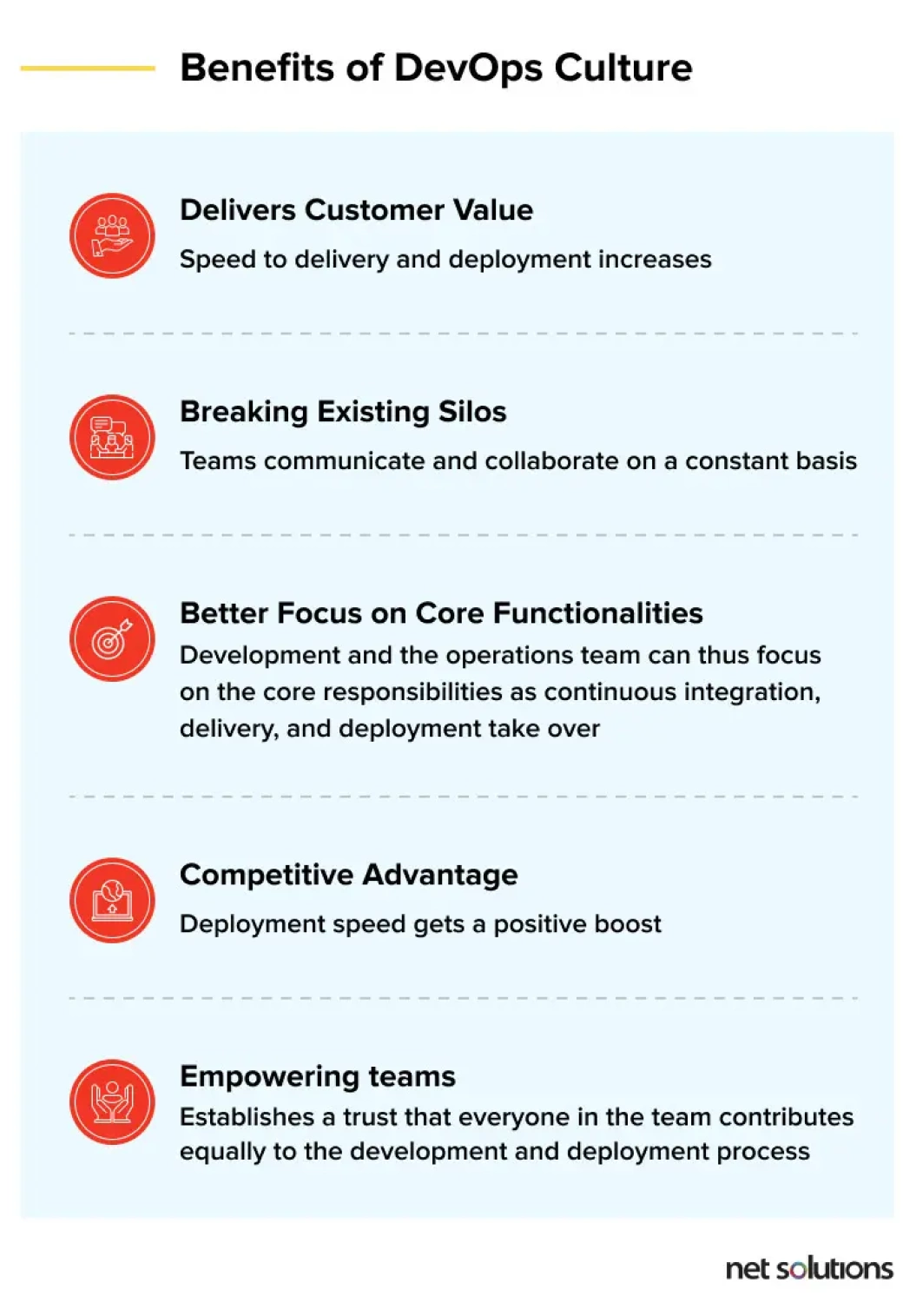
Importance of DevOps Culture for Business
According to the Accelerate State of DevOps Report, 2019, the percentage of DevOps teams has been increasing over the years.
Participants who work in DevOps teams have increased since we began our study, reporting 16% in 2014, 19% in 2015, 22% in 2016, and holding steady around 27% for the past three years.
No doubt the DevOps transformation will require a complete restructuring of business processes, but the resultant efficiency and speed to market is something worth making that effort for. Quality improvement is another bonus of the adoption of DevOps.
In today’s automated era, software plays not just a supportive role for a business but a core integral role in running a business. Every part of the value chain in a business process – communication, operations, logistics – uses software to optimize efficiency.
Similar to how physical goods companies transformed how they design, build, and deliver products using industrial automation throughout the 20th century, companies in today’s world must change how they build and deliver software.-AWS Amazon
DevOps pushes organizations to optimize their complete systems for overall business improvement. It gets them to be more adaptive & data-driven to better align with the customer demands & business needs.
10 Steps to Build a DevOps Culture
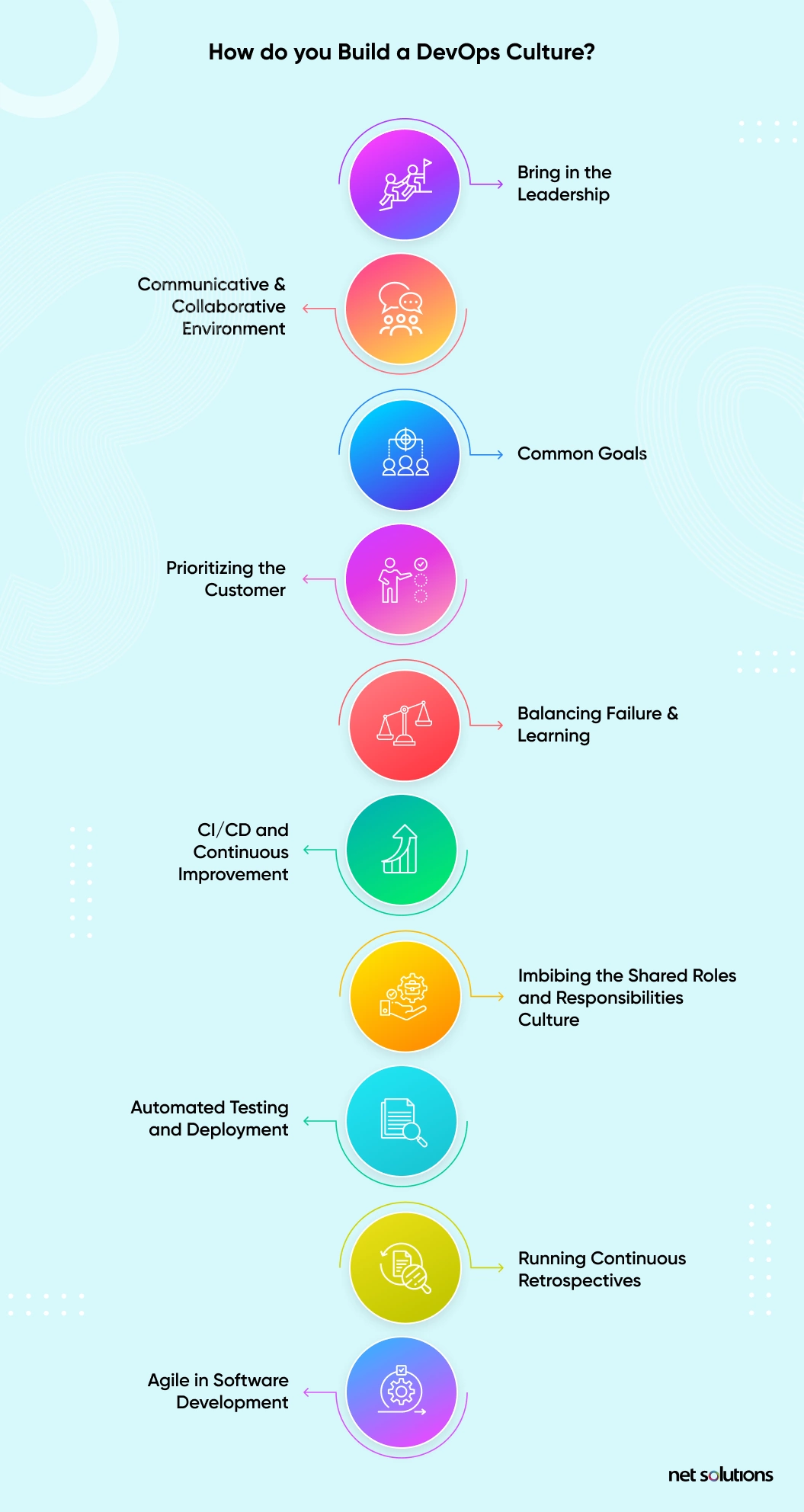
1. Bring in the leadership
Like any transformational process, when you have team leaders endorsing the changes, you stand a greater chance of operating without resistance. The more convinced senior executives and team leaders are about the process, the better it is for the entire process. There is lesser resistance from the team members or seniors. This will also bring about a cultural shift in the business- mostly from top to down. The grassroots level changes can be slower, but management support & initiatives from the top work better to create the right environment.
2. Communicative & Collaborative Environment
The idea is to foster a combined working environment between the development & operations teams. Collaboration leads to delivering common objectives. Silos are broken down, and the emphasis is on joint working – exchanging and sharing ideas, solving problems, and communicating regularly. When you align teams for the DevOps culture, it helps to have mutual conversations with them about resources, schedules, requirements, features, and execution of the projects. Communication brings invaluable insights and inputs, thus letting the teams avoid certain blockers from the beginning.
3. Common Goals
Shared responsibility is what we are looking at here. Common goals, cross-functional working, and teams with a different skill set working together to plan, build, deploy and improve software works the best. When everyone pools their skills and works on shared resources, the result is a streamlined development process.
An inclusive process implies that each member understands their role in software development and can take care of the task assigned or the problem they are supposed to solve. Common goals demand a sharing of knowledge. With these two as the base for working together, teams are encouraged to go beyond the boundaries of their expertise and innovate more.
4. Prioritizing the Customer
A DevOps culture is supposed to emphasize the ever-evolving customer needs. Businesses gather data from automated processes. Wisdom lies in knowing which section of the data to focus on. Team alignment & task allotment revolves around what will make your customer happy.
5. Balancing Failure & Learning
Every organization needs to change its attitude toward failure if it has to align itself with DevOps. The moment you accept failure, you become more open to learning. If a team feels comfortable about failure in a work process, they will be fine with a climate for learning from reviews.
Learning at every step of the process and then sharing with the concerned teams only helps improve project management. Documenting issues, reviews, and feedback allows teams to understand weak points and work on them. In the DevOps culture, end-to-end responsibility is essential to the entire process. All team members must know how to streamline their tasks and how their tasks/failures/learning will impact others’ roles.
6. CI/CD and Continuous Improvement
One of the most important aspects of the DevOps culture is that brands must adapt to changing circumstances. This could be new technology or market demands, or changes in regulations. But there must be continuous improvement to maximize performance, cost, and speed-to-market. The fact that DevOps gets teams to work in optimized processes & with automation lends support to continuous integration and delivery pipelines. Efficiency in application build & deployment is the natural outcome.
The DevOps culture supports taking small steps for consistent improvement. With CI/CD, feedback comes in and is addressed fast, too – iterations happen back & forth, thus getting a quick response to customer needs. Major failures get avoided, automation helps in smooth deployment, and testing during the lifecycle helps detect problems faster.
7. Imbibing the Shared Roles and Responsibilities Culture
Embracing new roles and responsibilities is a prerequisite in a DevOps culture change. The need is to polish existing skills and fill the current skills gap to ensure that DevOps’ initialization leads to a fruitful outcome. There is no exclusivity to development in a DevOps setup, and the same stands true for operations. Instead, they are now one team with shared responsibility for completing the task at hand.
Moreover, the automated approval systems lend a hand in smudging the difference between the independent teams. This new setup helps them collaborate and communicate better and helps the Devs and Ops team wear each other’s hats for a better understanding of the process.
The shared responsibilities of the Devs and Ops team include:
- Joint planning for product development and infrastructure deployment
- Build a CI/CD (Continuous Integration/ Continuous Delivery) pipeline
- Prioritizing automated testing to ensure timely bug fixtures, redeployment, and maximized delivery speed
- Building an automation-led culture to cut down on the traditional approval and sign-offs practice
- Immediate response management when tickets are raised
8. Automated Testing and Deployment
Automation is a kind of cornerstone for the DevOps culture. It aids collaboration. Automated testing is a critical process that helps in managing continuous integration. The automated test suites ensure that the test results are authentic and that there is no room for human error. This, in turn, helps the testing team report errors and the development team work through them for fixtures. Automated deployment ensures that the DevOps team maintains product quality and delivery speed when the bugs are fixed. The fundamental objective is to shorten the release cycles through automation. It helps eliminate the obligation to seek approvals and manages unwanted delays while offering value. Automating important processes (new systems, software deployment, security issues, etc.) helps DevOps teams deliver software without delays.
9. Running Continuous Retrospectives
If continuous improvement and learning need to be embedded in the system, retrospectives cannot be given a miss. Traditionally, a retrospective is an agile practice where the development team shares their learning from past projects — weighing what they did right against what went wrong.
The upshot of running retrospectives is to find out what needs to change to avoid past mistakes. In a DevOps setup, running a retrospective is highly recommended. These retrospectives help identify:
- Discuss the exciting gaps in the delivery and deployment cycles (concerning the previous sprint or project)
- What went well, and where do you need to improve
- Are the processes, DevOps tools, automation, and people in place?
- If there was a visible outage, who was responsible?
- What impediments cause harm to the DevOps practices — Is it the mindset, the lack of process or tools, or unawareness?
The goal here is simple — find what is going well, work on polishing it, find out what is amiss, and look for ways to accommodate it in the next sprint cycle.
10. Agile in Software Development
The software teams should be practicing agile methodology, along with CI. First, Agile broke the silos between requirements, testing, and development. DevOps culture tries to remove the silos between development and operations and encourages collaboration.
For a DevOps culture, agile in software is essential – so that a software development flow is created to push code out at least once a day, with coding targeting a sequential, simplistic approach. A constant collaborative workflow should induce the required automation to update software and infrastructure automatically as per desired changes.
DevOps Culture: Challenges
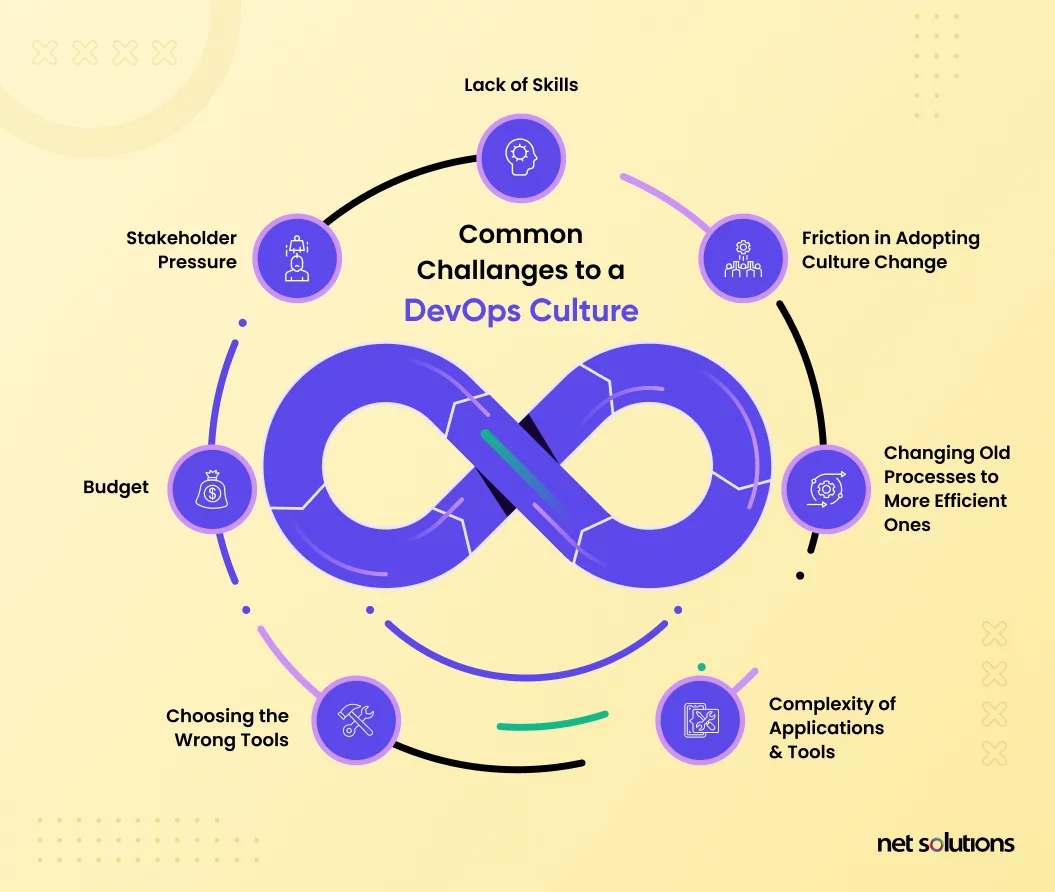
Implementing DevOps practices may not be a rosy journey unless planned and executed correctly. Some of the impediments include — lack of skills, friction in adopting culture change, inability to adopt better and advanced methods, the complexity of applications and tools, and choosing the wrong tools (what worked for others may not be best for you), budget, and stakeholder pressure.
Overcoming the Pitfalls of Implementation of DevOps Culture
As with any adoption, the initial phase is complex and full of ups and downs. While implementing DevOps culture, Pitfalls have a similar story and can be overcome with a focused strategy for each pitfall.
For instance, lack of skills, lack of culture, and test automation can be overcome by skill enhancement programs/ training. A well-thought-out training program will have a two-fold positive effect:
- Skill enhancement
- Employee engagement
Application complexity is subjective and hence should be seen differently. The DevOps pipeline for one project may be very different from another. The pipeline will depend on the application’s technology, domain, and complexity.
DevOps pipeline for Azure will rely primarily on the Azure DevOps toolkit. In contrast, the DevOps pipeline for an on-premise or AWS deployment may use a toolkit like Jenkins, CircleCI, etc.
It is suggested to apply the 80-20 rule and see the projects or technology lines that can fall into one category and be brought on a single DevOps pipeline and toolchain. These should be high-value projects, and having them on board will give the necessary impetus to the team’s culture and morale.
Once the toolchain is established, other projects should be considered and brought to the DevOps pipeline.
Also, an organization must invest in people, policies, and products (toolchains) to implement the DevOps culture. This investment should be budgeted and carefully run as any other project. The team should know the budget and timelines and work according to the speculated timelines.
Frequently Asked Questions
DevOps involves various tools, processes, team collaboration, communication & integration to streamline the software development process. It encompasses different entities like CI/CD; each entity works within its own set of tools, combining processes, multiple roles, and tools. It creates an ecosystem and is more of a ‘culture’ than a singular role.
While Agile and DevOps both seek to smoothen the process of software development, making the release of the end-product faster & efficient, they aren’t the same. There is a difference between the two. Agile is about a mindset, a leadership initiative promoting teamwork, self-organization, and accountability. It is about fast iterations to constant change. DevOps is about bringing software development and operations together. It is a culture encouraging communication & collaboration. Both are breaking silos – Agile between development & requirements; DevOps between development & operations.
The secret to a constructive DevOps program is careful measurement and monitoring. Some KPIs to be kept in mind are Change volume and lead time, deployment frequency of the code, the volume of errors, time to diagnose an issue and time to recover, the unplanned work to be handled, and the application performance. SLA or the service level agreements matter a lot too.
Both technical & non-technical persons. Many people have gotten into the DevOps industry without having learned the software part of it. There is a rising demand for people working in DevOps. It would do well if you could make some effort to learn about the skills related to development & employment, automation, team collaboration, IT agility, and a real-world practical understanding of software requirements and deployment. Certifications can be attained, and you can become an expert in operating in this area that’s become a buzzword.



